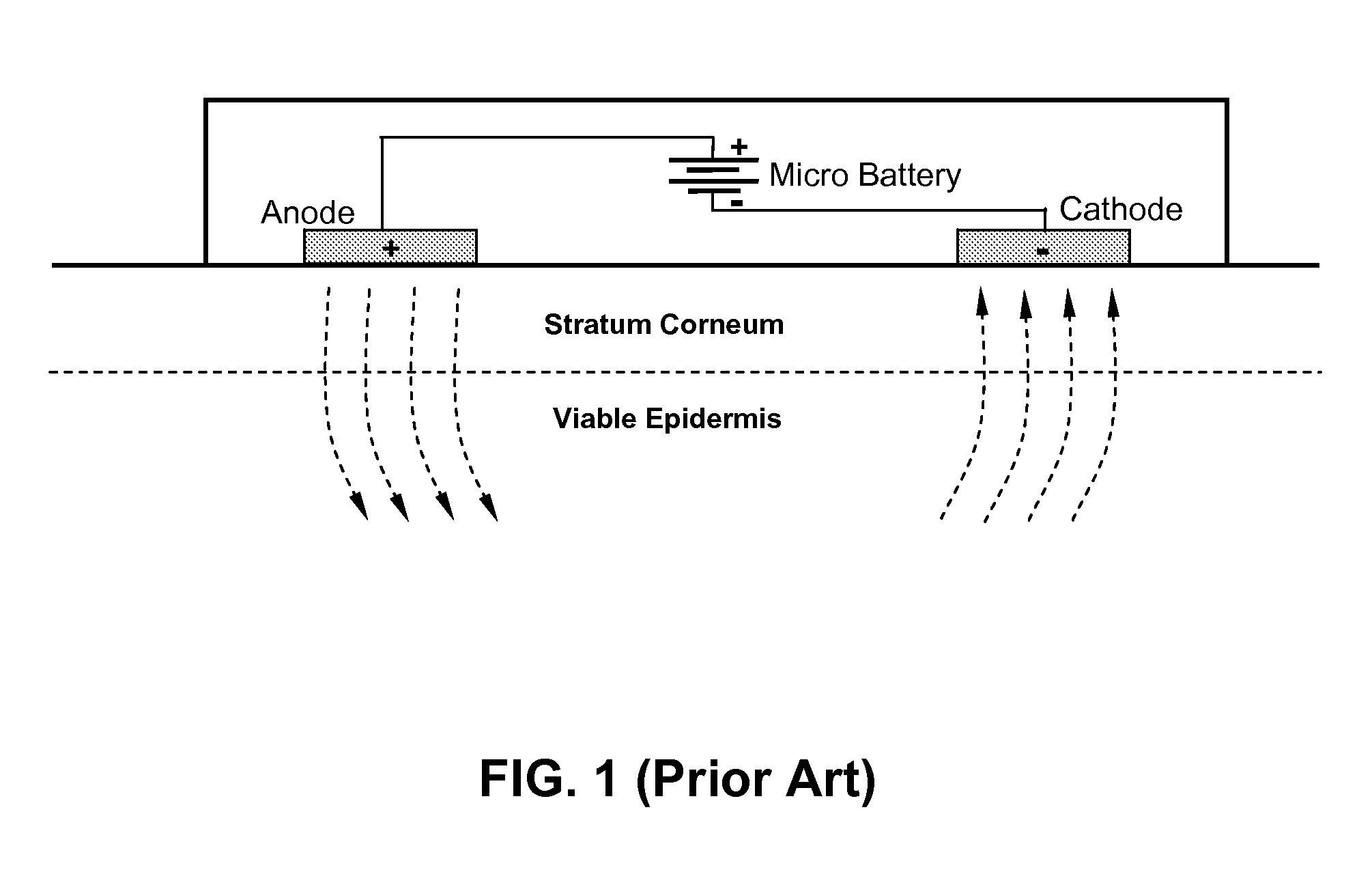Microcurrent-generating topical or cosmetic systems, and methods of making and using the same
a technology of microcurrent and cosmetics, applied in the field of topical or cosmetic systems and skin treatment methods, can solve the problems of skin irritation or inflammation, prohibitively expensive and complicated, and the purpose of nonaquatic vertebrate vertebrate vertebrate is not readily apparent, and achieve the effect of preventing or treating skin damag
- Summary
- Abstract
- Description
- Claims
- Application Information
AI Technical Summary
Benefits of technology
Problems solved by technology
Method used
Image
Examples
example 1
Cosmetic Patch with Al—Cu Electrodes
[0059]A cosmetic patch was formed by placing two identical hydrogel patches (about 2.5 inches in length and 1.5 inches in width) back-to-back. Sandwiched between the two hydrogel patches were two narrow metal-containing strips, one of which was an aluminum foil strip about 6 cm in length and 6 mm in width, and the other of which was a fabric strip about 6 cm in length and 6 mm in width and electro-plated with copper. The two metal-containing strips were spaced apart from each other and positioned in a parallel relationship with a distance of about 1 inch therebetween. Optionally, an electrolyte gel was applied to a top surface of one of the hydrogel patches so as to increase the intensity of the electric current that flowed between the two metal-containing strips through the hydrogel patches. Specifically, the electrolyte gel contained about 91 wt % of deionized water of, about 3 wt % of sodium chloride, about 1 wt % of phenoxyethanol, and about 5...
example 2
Cosmetic Patch with Al—Ag Electrodes
[0061]A cosmetic patch was formed by placing two identical hydrogel patches (about 2.5 inches in length and 1.5 inches in width) back-to-back. Sandwiched between the two hydrogel patches were two metal-containing strips, one of which was an aluminum foil strip about 6cm in length and 6mm in width, and the other of which was a fabric strip about 6 cm in length and 6 mm in width and electro-plated with silver. The two metal-containing strips were spaced apart from each other and positioned in a parallel relationship with a distance of about 1 inch therebetween.
[0062]In order to measure the current intensity of the microcurrent generated by the cosmetic patch, the metal-containing strips were connected with respective electrodes of the above-described DIGITAL MULTIMETER through a 10 ohms resistor. The cosmetic patch was applied to a skin surface, and the current intensity generated by the patch was measured over time. When no electrolyte gel was appl...
example 3
Cosmetic Patch with Cosmetic Compositions as Electrodes
[0063]First and second cosmetic compositions containing the following ingredients were formulated by mixing the various phases together in sequence to form homogeneous mixtures.
TABLE 1First Cosmetic Composition (−)AmountPhaseIngredients(wt %)1I-Malachite Water (I Water bound46.86with Cu ions)Disodium EDTA0.10Arginine0.042Aloe barbadensis leaf juice45.00Aminopropyl ascorbyl phosphate0.10Water / sweet almond seed extract0.203Sodium acrylate / sodium2.50acryloydimethyl taurate copolymer / / hydrogenated polydecene / / laureth-84Hydrogenated polydecene3.505Caprylyl glycol / phenoxyethanol / 0.50hexylene glycol6Ethylhexylglycerin0.20
TABLE 2Second Cosmetic Composition (+)AmountPhaseIngredients(wt %)1S Water70.15Glycerin6.00Caprylyl glycol0.80Sodium stearoyl glutamate1.35Isostearamidopropyl dimethylamine0.60Algae extract0.40Porphyridium polysaccharide0.40hydroxypropyltrimonium chlorideMethoxy PEG / PPG-7 / 30.20aminopropyl dimethiconeCaprylyl glycol / phe...
PUM
| Property | Measurement | Unit |
|---|---|---|
| Current | aaaaa | aaaaa |
| Current | aaaaa | aaaaa |
| Electrical conductivity | aaaaa | aaaaa |
Abstract
Description
Claims
Application Information
 Login to view more
Login to view more - R&D Engineer
- R&D Manager
- IP Professional
- Industry Leading Data Capabilities
- Powerful AI technology
- Patent DNA Extraction
Browse by: Latest US Patents, China's latest patents, Technical Efficacy Thesaurus, Application Domain, Technology Topic.
© 2024 PatSnap. All rights reserved.Legal|Privacy policy|Modern Slavery Act Transparency Statement|Sitemap



